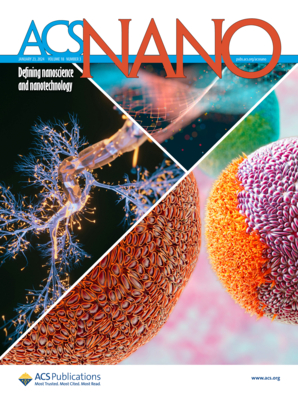An Asynchronous-Regulated Nanosheet Cascade Amplifies Sonodynamic-Triggered Self-Enhanced DNA Damage for Intensive Tumor Immunotherapy.
IF 15.8
1区 材料科学
Q1 CHEMISTRY, MULTIDISCIPLINARY
引用次数: 0
Abstract
DNA damage can potentially trigger innate immune responses, providing a feasible way for immunotherapies to target "cold" tumors (T cell-deprived). However, DNA damage resistance and immunosuppression severely compromise tumor therapeutic efficacy. We therefore developed an ultrasound-activated and asynchronous-regulated nanosheet (ECHO). This system achieved cascade amplification of self-enhanced DNA damage via sonodynamic therapy, enabling potent tumor immunotherapy. Upon ultrasound activation, the peroxidase-like property conferred ECHO with the capability to induce precise and potent DNA damage by triggering ROS explosions, while leveraging the Russell mechanism to continuously generate ROS within the tumor microenvironment, heightening cellular susceptibility to DNA damage. Then, STING was activated and enhanced by DNA fragments and Mn2+ released from ECHO, respectively, which in turn disrupted ROS clearance for reversing tumor resistance to DNA damage and boosting innate immunity. Simultaneously, Niclosamide inhibited STAT3 in DNA repair response and counteracted immunosuppressive effects. The asynchronous regulation of STING and STAT3 increased ROS absolute content and restrained DNA repairing, facilitating self-enhanced DNA damage, thus intensifying tumor immunotherapy. ECHO effectively targeted tumors with minimal adverse effects, leading to 87% tumor regression and 40% contralateral bilateral tumor elimination. Overall, our asynchronous regulation strategy achieved self-enhancing DNA damage and offered a promising prototype for intensive tumor immunotherapy.一种异步调节的纳米片级联放大声动力触发的自我增强DNA损伤用于强化肿瘤免疫治疗。
DNA损伤可以潜在地触发先天免疫反应,为免疫疗法靶向“冷”肿瘤(T细胞缺失)提供了一种可行的方法。然而,DNA损伤抵抗和免疫抑制严重影响肿瘤的治疗效果。因此,我们开发了一种超声激活和异步调节的纳米片(ECHO)。该系统通过声动力治疗实现了自我增强DNA损伤的级联扩增,从而实现了有效的肿瘤免疫治疗。超声激活后,过氧化物酶样特性赋予ECHO通过触发ROS爆炸诱导精确和有效DNA损伤的能力,同时利用罗素机制在肿瘤微环境中持续产生ROS,提高细胞对DNA损伤的易感性。然后,STING分别被ECHO释放的DNA片段和Mn2+激活和增强,进而破坏ROS清除,从而逆转肿瘤对DNA损伤的抵抗,增强先天免疫。同时,氯硝柳胺抑制STAT3在DNA修复反应中的作用,抵消免疫抑制作用。STING和STAT3的异步调控增加了ROS绝对含量,抑制了DNA修复,促进了DNA的自增强损伤,从而强化了肿瘤的免疫治疗。回声有效靶向肿瘤,不良反应最小,87%肿瘤消退,40%对侧双侧肿瘤消除。总的来说,我们的异步调节策略实现了自我增强的DNA损伤,为强化肿瘤免疫治疗提供了一个有希望的原型。
本文章由计算机程序翻译,如有差异,请以英文原文为准。
求助全文
约1分钟内获得全文
求助全文
来源期刊

ACS Nano
工程技术-材料科学:综合
CiteScore
26.00
自引率
4.10%
发文量
1627
审稿时长
1.7 months
期刊介绍:
ACS Nano, published monthly, serves as an international forum for comprehensive articles on nanoscience and nanotechnology research at the intersections of chemistry, biology, materials science, physics, and engineering. The journal fosters communication among scientists in these communities, facilitating collaboration, new research opportunities, and advancements through discoveries. ACS Nano covers synthesis, assembly, characterization, theory, and simulation of nanostructures, nanobiotechnology, nanofabrication, methods and tools for nanoscience and nanotechnology, and self- and directed-assembly. Alongside original research articles, it offers thorough reviews, perspectives on cutting-edge research, and discussions envisioning the future of nanoscience and nanotechnology.
 求助内容:
求助内容: 应助结果提醒方式:
应助结果提醒方式:


